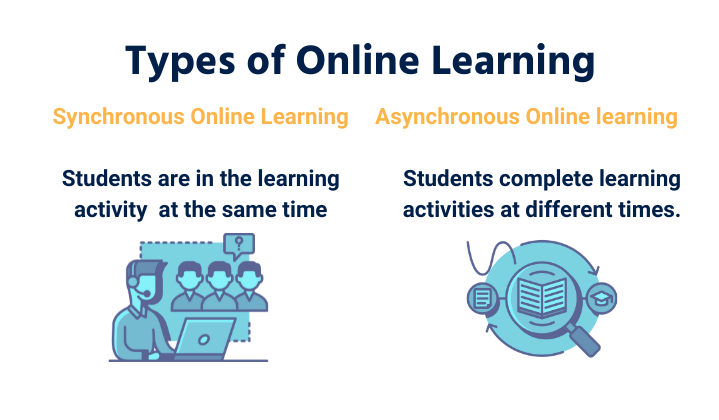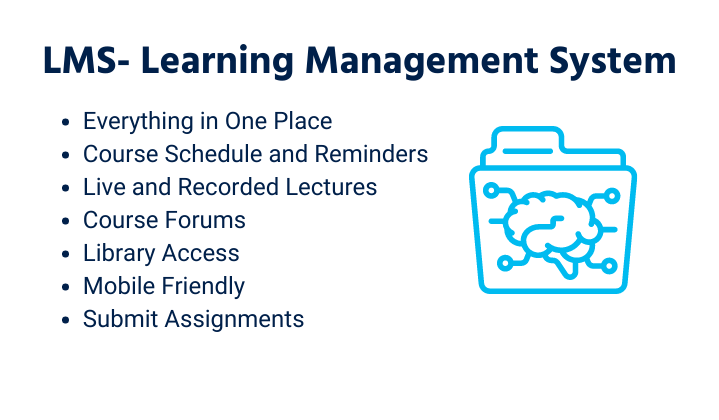Distance learning is a form of study where students and tutors are not physically in the same place. The first notable example of distance learning in the UK was a shorthand correspondence course delivered by post in 1840. Now more commonly known as online learning, millions of students take online courses each year globally.
As the number of online courses and students has increased, so have the types of course formats and flexibility offered. Nowadays, instead of waiting for the postman to deliver feedback, distance learning students can speak with tutors in real-time, pause and rewind lectures and access millions of books and journals from the university’s online library.
Types of Distance Learning
The term distance learning is not as common as it used to be. The ‘distance’ part has become less relevant as computer capabilities, and internet speeds have advanced. Distance learning is now more often called online learning, e-learning, flexible learning or web-based learning.
Online learning can be broadly broken down into two main groups
- Synchronous Online Learning- the students learn at the same time
- Asynchronous Online learning- students complete learning activities at different times.
Most distance learning degrees and online masters will combine the above learning styles in a similar way to on-campus courses.
Synchronous Vs Asynchronous Learning: What Is The Difference?

- Synchronous learning involves students participating in the learning activity simultaneously, such as engaging in online tutorials or lectures.
- Asynchronous learning is when a student completes the learning activity and works through the study materials in their own time at their own pace.
What is Blended Learning?
Blended learning is a mixture of online and face-to-face activities. For example, a distance learning student takes a face-to-face module on an otherwise online course.
A blended learning option is often a feature of online degrees and master’s courses but is less common in short courses and MOOCs.
What are Distance Learning courses Like?
Online Distance learning courses can generally be split into two groups, open scheduled and fixed time.
Open Schedule Online Courses
Open schedule online courses are typically found on MOOCs (Massive Open Online Courses). These programmes are generally made up of asynchronous learning materials and activities. This structure gives students the most flexibility to learn at their own pace and control over the learning process. Easy access has opened up some genuinely world-class universities and learning materials to the general population. However, the downside of this flexibility and freedom is that it takes self-discipline and dedication to complete assignments. Open schedule learning is primarily self-study which may not suit all learners.
Fixed Time Online Courses
Fixed time online courses, as the name suggests, have set deadlines to complete assignments and the course as a whole. This type of distance learning program typically involves both asynchronous and synchronous learning.
Modern online learning tools have enabled the delivery of traditional teaching methods online. Students benefit from being able to attend live events online with the tutor and fellow students, as well as the flexibility to undertake most of the learning asynchronously. The strength of this type of online learning and social interaction is that it keeps students engaged and motivated as they progress. However, the drawback is that this type of online learning offers less flexibility.
If you are reading this article, you are most likely thinking about taking an online university-level course, trying to understand what exactly is involved. Almost all modern distance learning degrees and masters follow a fixed time course structure. Below we will cover the main components of contemporary online learning.
What is Remote Learning on a Master’s Degree Like?
Modern online master’s degrees have come a long way from the original correspondence courses. Typically they are structured within a set time to complete. Students have fixed dates when access to modules opens, slots where they can book time with tutors for one-to-one support, live lessons or webinars that they can join, and assignment deadlines.
However, they also get the distance learning benefits of deciding when they fit in the bulk of their study around their other commitments.
This timetabled structure means that all the students are going through and experiencing the course at the same time. This enables engaging online discussions and a sense of community even though everyone is studying remotely.
Online learning in this way is ideal for mature students who are looking to juggle getting a university degree with work and family commitments.
LMS- Learning Management System
The Learning Management System (or LMS) is an online platform that provides a virtual learning environment. This is where online students spend most of their time interacting with the tutors and other students, accessing the course schedule and content, and submitting assignments.
The design and capabilities of modern LMS’ make online education a rich and interactive experience. For example, the most widely used platforms can deliver lectures and video conferences and store all student records and course progression information.
Most LMs are also accessible on mobile phones and integrate with calendar apps. As a result, students can keep track of upcoming deadlines and activities, and access live and recorded content while on the go.
Online Lectures And Webinars
The original correspondence courses really were distant in the time between interactions. In the 70s and 80s, the Open University in the UK pioneered distance education by incorporating lectures broadcast on state TV in the early hour of the morning. Students back then either stayed awake to watch them or, where possible, recorded them on VHS tapes to view at a more convenient time.
Current online courses incorporate live and recorded video conferencing and lectures as standard, often with transcripts included. Once a module or unit becomes available to students, they have access to the recorded lectures. They can then attend live tutorials or webinars at set time slots. Most courses run these live events at multiple time slots to cater to students in different time zones and remote regions.
In fact, now, having access to recorded lectures is a standard offering for on-campus courses. This trend was growing before covid, but the pandemic has accelerated this adoption of hybrid learning. It is now common to have lectures recorded and broadcast live and be available to pause and rewind later for on-campus students as well. This adoption is an example of online learning tools and flexibility spreading to traditional classroom instruction based courses.
Online Debates and One-to-One Tutor Time
Historically, one of the main differences between on-campus and distance learning degrees is the amount of interaction with tutors. Teaching online is now possible in ways that were not possible in the past. Students have regular opportunities to participate in real-time debates and tutorials on well-structured courses. The number of live sessions will vary between courses and tutors. The most common formats delivered online are
Live Webinars – these are usually at set points in the module. All students are invited, and the format can vary from covering specific areas focused on a set topic to open Q & A sessions. Recordings are usually available after the event.
Live Drop-in Sessions– these are set periods where a tutor will be available online in an online meeting room. There is no assigned topic, and the sessions are open to any questions, and queries students have. There can be multiple students in the meeting with the tutor at any one time.
Dedicated one-to-one meetings– depending on the course and tutor, the flexibility and access around these can vary.
It is standard for each type of session to run at several different time slots to ensure international students are not disadvantaged.
Course Forums
One of the challenges that online program designers have is finding the right balance between flexibility and live interaction. For example, having a fixed schedule when all students need to attend an online event is the opposite of being flexible. Once you add differences in time zones and the existing commitments of mature students, it becomes impossible to have a compulsory timetable for live sessions.
Nearly all online courses have forum areas for students and tutors to discuss topics asynchronously in addition to the live lessons mentioned above. The forum can often act as the main focal point for a course.
This is where the tutor can post information or questions to start debates. While a forum may not sound as exciting as online lectures, most students greatly appreciate the flexibility to catch up and add to the discussions in an asynchronous way.
This engagement plays an essential role in online learning. Participating in the forums is counted as a graded activity on many courses.
Access To Online Libraries
When you join an online degree or master’s, you have access to the university’s online library, where you can access digital copies of the reading list as well as academic and industry journals. On most courses, you do not need to purchase additional textbooks. All the resources are available via the courses LMS or through the university’s online library.
Distance Learning Certification
If you take an online degree or master’s at most UK universities, the certificate you gain will typically be the same as the on-campus equivalent and not mention the study method.
Useful Links
Complete list of UK universities offering online courses
Costs and funding for online study

